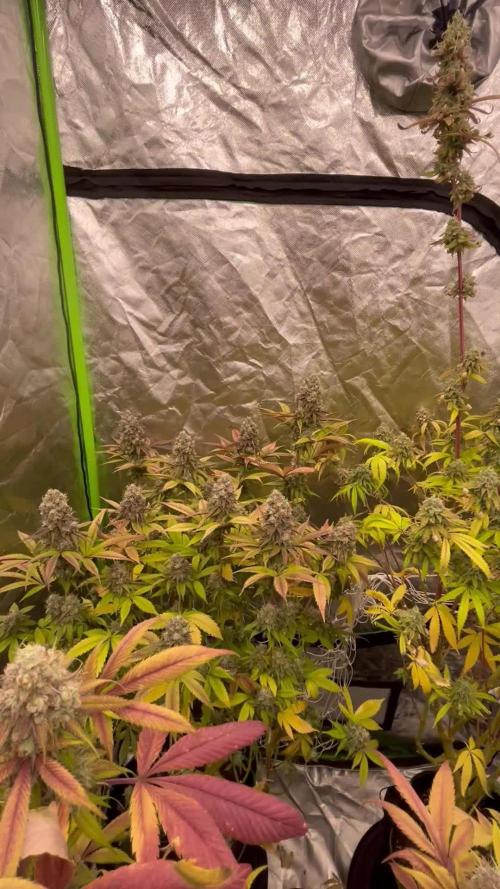The Grow Awards 2026 🏆 



























Likes
10
Share


@tontodedoverdee
Follow
18/4
So, we had an amazing week, the Runtz grow of 10 extra cm during the flowering stretching , the buds are getting rich of fuzzy withe pistils, and the smell it's getting much stronger,
from the second node starting from the bottom, both the branches had split creating 2 heads on the same branch, I've never see something like this before.
As you can see from the picture the lower buds are flowering a bit slower than the ones on top, now it's kind difficult take some pics since the plant grow so much!
Likes
7
Share


@Weedganja420
Follow
Ya huele para comersela, tiene un olor dulce muy fuerte.
Lleva 30 dias a 12/12 horas.
Sigo fertilizando con los productos de terranabis.
Vamos a ir viendo como engordan esas flores.
Likes
8
Share


@Campesino
Follow
Men, I don't know if was the nutrients, pots, new light or the second time. The size is rly big than the first time. The Torpedo double the size of the first time.
Some old leaves are drying, taking an orange, by the other, same on the tip are taking a little effect. Maybe is 'cause by overnutrition.
This week over the vegetative stage, and the smell will be more stronger since now.
Likes
20
Share


@ukterpdoc
Follow
Been going so well plants looking amazing they're going to find bigger pots by next weeks update and be in the veg room under there new lights and out of the tent lots more space and lots more light
Likes
66
Share


@Experimentgreen
Follow
Getting ready for the flowering flip. I'm interested to see what their stretch will be like, this is my first time doing extensive LST....hopefully it helped out. I'm glad to see the plants are at least pretty even in height.
There's roots popping out of every piece of the fabric pots....i really wish i did a 5 gallon...i don't want to try to transplant them cause it's real difficult using a fabric pot or i have to cut the fabric.
Both plants have had more yellow pale bottom leaves so I think they must be some hungry little hippos or possibly the organic nutrients need a slightly heavier dose than recommended.
Happy holidays!
Likes
23
Share


@Sators
Follow
🌱Day 30. Flower start showing some nutrients deficiency. I will drop down ph level and have a look how it is work.💚
🌱Day 32.💚
🌱Day 34.💚
Processing
Likes
3
Share


@GanjaFarmerGrow
Follow
Dispite the bad air and heat that she took..
she is starting to recover...
I hope she heals...
She has started to produce some flowers...
fingers crossed.. 🙏
Likes
21
Share


@cadur
Follow
Growing very nicely. I've not added any nutrients at all. Using miracle grow organic soil (no nutrients added to the base soil at all by the manufacturer)
Likes
54
Share


@MarsHydroLED
Follow
new grow started by @polasekplants 😁
This time there are blue dream, girl scout cookies, forbidden fruit, and white kush seeds started in a peat moss soil with about 60% already pop.
Mars hydro tsw2000 is set at 25% power and at 36in above the seedings.
Likes
169
Share


@SlowpokeFuegobud
Follow
🍊 🐶 💜 🍊 🐶 💜 🍊 🐶 💜 🍊 🐶 💜🍊 🐶 💜 🍊 🐶 💜 🍊 🐶 💜 🍊 🐶 💜
Welcome to week 10, my fellow growmies!! 💚 💚 💚
DAY 66
Watered with 4ml bloom + pk+ humics + growzyme + bigfruits + 2ml calmag💧
DAY 68
Watered with 4ml bloom + humics + growzyme + bigfruits + 2ml calmag💧
DAY 70
Watered with 2ml bloom + 4ml humics, growzyme + bigfruits + 2ml calmag 💧
Thanks for stopping by, it's a true pleasure to have you as visitors!! 💚 💚 💚 😘
💜 🐘
______________________________________________________________
About Sour Tangie Dawg cannabis seeds
Sour Tangie Dawg is a sativa dominant cross between the famous Tangie and Chemdawg. Expect a combination of sweet & fruity mixed with a gassy, jet-fuel flavour. The amazing mix of citrus, tangerine, pine and gasoline produces uniquely rich, dank buds. The powerful sativa high is strong, uplifting and long lasting, great for creativity and socialising.
Chemdawg is the parent of OG Kush, all Diesel strain originate from Chemdawg. The Tangie is originally a Skunk hybrid strain but extremely fruity with the trademark Tangerine flavour. This strain is potent with THC-levels over 20% alongside very generous yields of top quality weed, very suited for hash and rosin producers. If you’re looking for a strain to produce the best tasting concentrates this Sour Tangie Dawg is a proven winner! She easy to grow and the perfect choice for SCROG growing due to her growth speed and stretch. We advise switching to 12/12 light when 75% of the net is filled. For outdoor growers the harvest period is early October. Indoors she’s finished after 9 weeks of flower - fast for a sativa dominant strain. We recommend growing in soil with organic nutrients for the best tasting weed.
Get some fantastic genetics here: https://supersativaseedclub.com/ 💜 🐘
___________________________________________________________________________
SETUP:
80x80x180 cm Zelsius
240W Full Spectrum LED IR UV dimmable
DW240H-A6-HS
Heatsink color red
LED Chips:
512pcs SAMSUNG LM301H + 24pcs Osram 660nm + 8pcs Osram IR 730nm + 8pcs UV 385nm
Color mix: 2700K + 4000K
2,8umol/J
Driver HLG-240H-C2100B
Coverage: veg 5x3ft / flower 4x2ft
Product size: 628x205x68mm
Green Buzz Nutrients
Shouts go out to my sponsors @GreenBuzzNutrients, thanks so much for your support! ❤️
If anyone would like to try their amazing organic products, use code GD42025 for generous 25% discount (for orders of minimum 75€) ✨
https://greenbuzznutrients.com/
Biobizz Lightmix
custom exhaust fan 320/270cm³/h
Carbon Active Granulate 240cm³/h
tab water pH 8 - EC 0,25 with Calmag to 0,5
Advanced Hydroponics pH minus Grow + Bloom to pH 6.2
🍊 🐶 💜 🍊 🐶 💜 🍊 🐶 💜 🍊 🐶 💜🍊 🐶 💜 🍊 🐶 💜 🍊 🐶 💜 🍊 🐶 💜
Likes
26
Share


@Ukfarmer420
Follow
Hi guys
So we are on day 42 from switch so going into week 7 now, these are a 45-50 day flowering plant, I will be using a ripner for the next 10 days then give it a final flush of just water at ph 6.2.
So there starting there fade now on some of the leaves and the buds are are fattening up.
There really really sticky and covered in trichomes. I'm really looking forward to the end result.
Temps and humidity are all good I took a few leafs off that was blocking buds but other than that its been a normal week.
Happy growing guys and keep it up 💚💚💚
Day 44 on the scrog there fattening up but jeez there's so many white pistils.
I'm not sure whether to just flush with alternating water and molasses or to use a ripner on it???? Any suggestions🤔
Thanks guys 💚💚💚
Day 47, started feeding bio heaven, bloom and topmax again for the next 2 weeks after a discussion about the organic range im using.
Buds are swealing and really sticky, smell really sweet now. Humidity and room temps are consistent to where I want them, no signs of powdery mildew or rot of any sort.
Stacking on the trichomes now too I cant wait to see the final finished plant in her glory.
Happy growing guys I thanks for looking 💚👌
Likes
22
Share


@SecretTreasures
Follow
Photos taken on day 56 of flowering (last day of week 8 of flowering)
We are entering the last week as planned. Today is day 57 of flowering, day 50 for the London Pound Cake X Zoap. Since last week, all the plants have gained a lot more trichomes. Nasha's Fat Freddy's Cat is becoming more and more purple, Mimosa X Orange Punch is becoming more and more peachy and London Pound Cake X Zoap is turning a light shade of pink. Meanwhile, the larger leaves around the tubers are already curling with resin and the smell in the tent is very intense. Only water is used. Some plants have an incredible resin production and some flowers are still swelling, which can be seen in the light green areas of the otherwise dark flowers. Some plants look more mature than others, but that's the way it is when you use seeds. Temperature is still around 25 degrees during the day and around 19 at night. One Fat Freddy's Cat plant has developed an 'albino tip', which according to my information it can be genetic, for example when plants are backcrossed for recessive traits and can be due to environmental factors such as growing too close to a powerful lamp, which is also the case here. However, only this one plant has this trait and it is only particularly pronounced on one tip and less pronounced on another.
Likes
36
Share


@Cannabis_King
Follow
This week went great she is supposed to be an auto but still hasn't followed so I'm setting up my 4*2 tent and flip her see if she is a photo
Likes
25
Share


@Hawkbo
Follow
Finally got my buddy to come out and add in a 20 amp outlet so I can fire up a better light. Still using quantum boards but with a 4500k spectrum. Got in a foliar with the Growzyme from green buzz liquids. Fed them right before I took the pics they look a little sad but hopefully they bounce back quickly. Not much else going on.
The code bangdang will get you discounts at..
Gorillagrowtent.com
Rainsciencegrowbags.com
KindLEDgrowlights.com and more (see Instagram Bio for @bangdangbuds)
Also check out my Instagram if your interested in entering a giveaway for a green buzz liquids starter kit including some living organics, fast plants spray and some seeds of the winner choice.
































